When it comes to compliance automation, Secureframe is a name that consistently stands out. Across hundreds of Secureframe reviews, the verdict is consistent - it takes the pain out of compliance and turns it into a process that actually runs itself.
The platform simplifies the entire cycle. Evidence collection, policy management, vendor tracking - all powered by Secureframe features designed to automate the manual parts of staying compliant. For companies scaling fast, that's a serious advantage.
Still, no platform fits every team. What works for a large enterprise might feel overbuilt for an early-stage startup just trying to check off its first SOC 2. That's why it helps to hear from people who've lived through both sides of compliance - the chaos and the calm.
So before you dive in, talk to our founders. They've helped hundreds of teams simplify security and compliance, and they know exactly what makes a platform the right fit for your stage.

Inside the Story of Secureframe
If that last-minute compliance panic felt familiar, you're not alone. It's the same moment that led to the birth of Secureframe.

In 2020, Shrav Mehta and Natasja Nielsen were running startups when they hit the same wall - compliance chaos. Policies in one folder, spreadsheets in another, and tools that didn't talk to each other. It was slow, frustrating, and expensive.
Shrav, a founder with millions of app downloads under his belt, decided it was time to fix the process. Secureframe was built to automate compliance, enabling teams to stay focused on growth rather than documentation.
The idea caught on fast. Within two years, Secureframe had over 2,000 customers and was on track to reach $20 million in revenue. Backing came from:
So far, it has raised about $79 million.
Today, Secureframe has teams across San Francisco, New York, Austin, Denver, Toronto, and London. This just proves it's far beyond the startup stage.
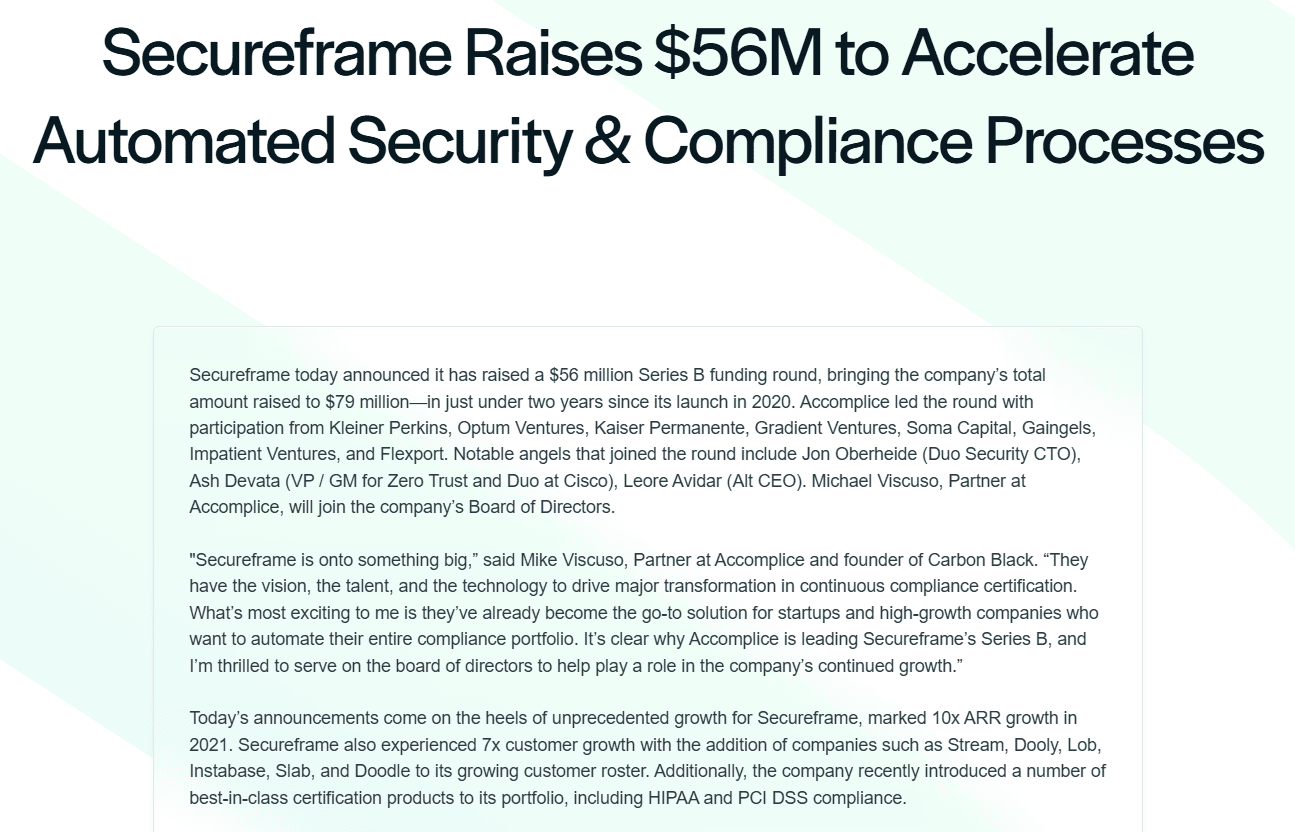
Recognition followed too. In 2025, Secureframe won Cyber Defense Magazine's "Hot Company - Compliance Automation" award at RSA. It also became one of the first compliance tools to support both NIST's AI Risk Management Framework and the new ISO/IEC 42001 standards for responsible AI.
Funding and awards don't guarantee a great product. But they show where the company's headed - toward the center of the compliance world, where security, automation, and trust meet.
Secureframe's mission is clear: help businesses build trust through automated security and compliance. Its broader goal is to simplify global compliance with automation, AI, and expert support.
And based on verified Secureframe reviews, that mission holds up. It's not flawless, but Secureframe features make compliance smoother and more predictable in a space full of big promises, that alone sets it apart from most Secureframe competitors.
A Deep Dive into Secureframe Features
If you strip away the marketing buzz, every compliance tool makes roughly the same promise: "We'll make security easy." But where Secureframe actually earns its reputation - at least from what you see in real-world Secureframe reviews, including G2 feedback - is in the details. It's not just that it automates checklists; it builds a full operating system for ongoing security and monitoring.

Here's what that looks like in practice.
Continuous Monitoring

- Always-on tracking for systems, frameworks, and controls.
- Real-time alerts when configurations drift, vendor certificates expire, or user permissions don't meet standards.
- Dashboards visualize control health so you know what's working and what's slipping.
- A favorite among security leads for replacing manual audit checks.
Automated Tests
- Auto-validates key controls and evidence daily - think of it as your audit checklist running itself.
- Helps catch issues before the next external audit cycle.
- AI detects incomplete or outdated data pre-audit, saving weeks of cleanup.
Integrations Library (150+ Tools)
- Connects with AWS, Azure, GCP, GitHub, Okta, Google Workspace, Slack, Jira, and more.
- Pulls evidence automatically - no more chasing screenshots or uploading PDFs.
- Plays nicely with most modern cloud stacks, which is why Secureframe G2 reviews often cite integrations as one of the platform's biggest strengths.
Policy Management
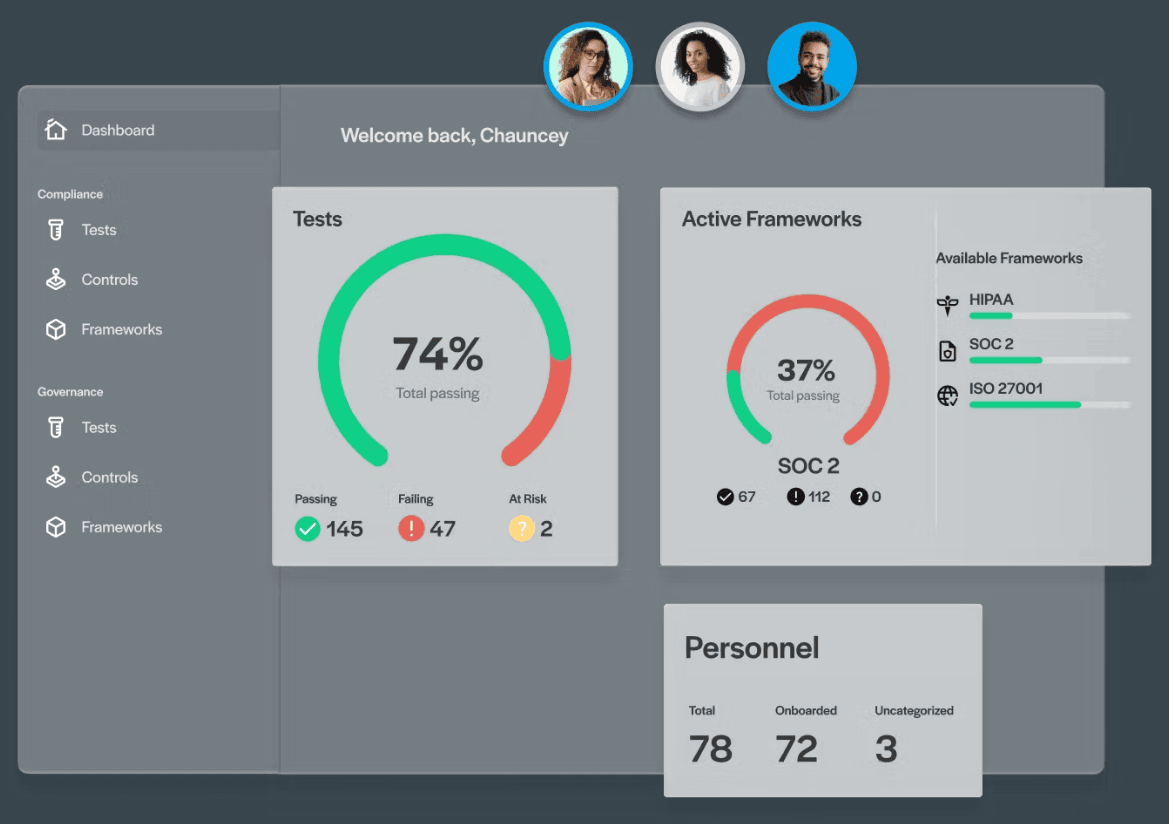
- Prebuilt, customizable templates for every major framework (SOC 2, ISO 27001, HIPAA, GDPR, etc.).
- Templates are written and maintained by compliance experts, so you start 80% done.
- Smart policy versioning - edit once, and changes propagate across controls and reports.
Personnel & Asset Management
- Tracks user access to sensitive systems across departments.
- Auto-updates when people join, leave, or switch roles.
- Maps employees to controls and evidence automatically - especially handy for onboarding/offboarding audits.
Vendor Management
- Streamlines vendor onboarding and risk scoring.
- Monitors vendor compliance (SOC 2, ISO 27001, etc.) through centralized evidence.
- Automated reminders when vendor certifications expire - critical for teams juggling multiple third parties.
Common Controls
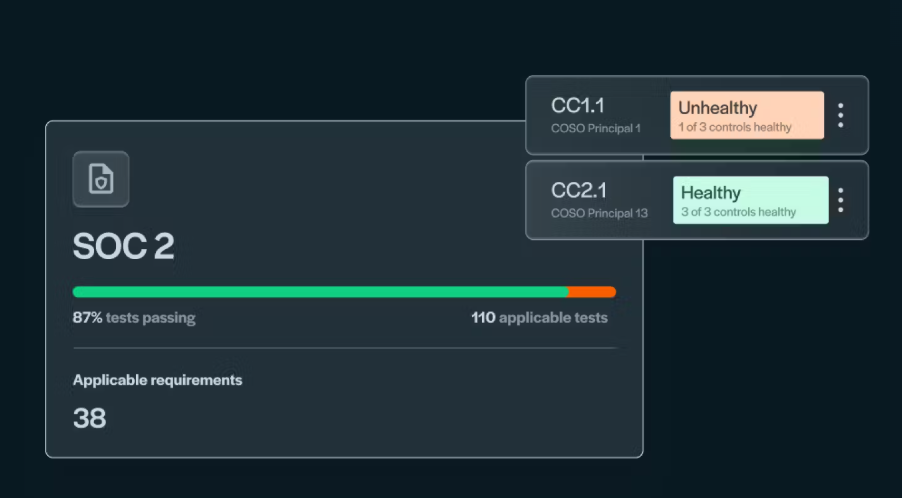
- One of the most underrated Secureframe features.
- Allows you to map a single control across multiple frameworks, including SOC 2, ISO 27001, and HIPAA, thereby reducing duplicate work.
- Ideal for companies scaling from one certification to multiple certifications.
Risk Register
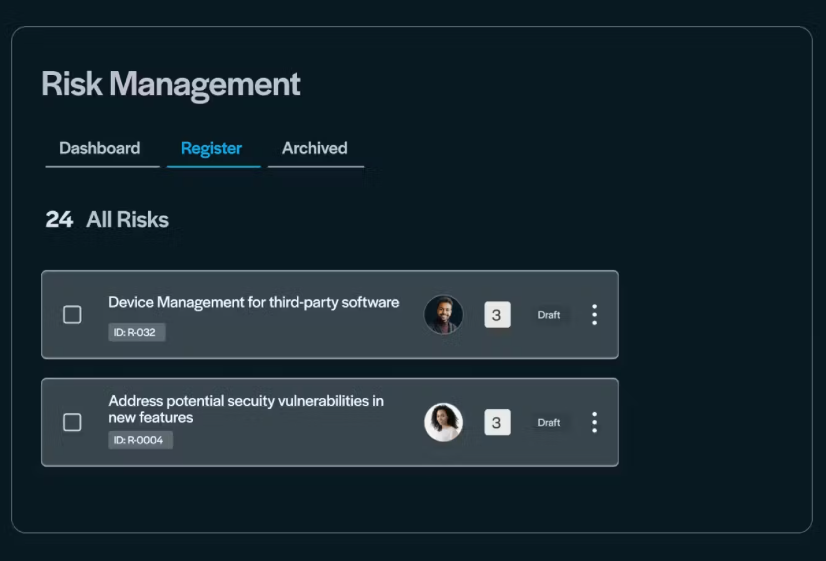
- Centralized dashboard to identify, score, and track risks automatically.
- Integrates with control mapping and remediation workflows.
- AI suggestions help prioritize what actually needs fixing - and what can wait.
Readiness Reports
- Real-time view of audit preparedness by framework.
- Visual progress tracker to keep leadership in the loop.
- Saves time coordinating between security, product, and operations teams.
Secureframe Trust Center
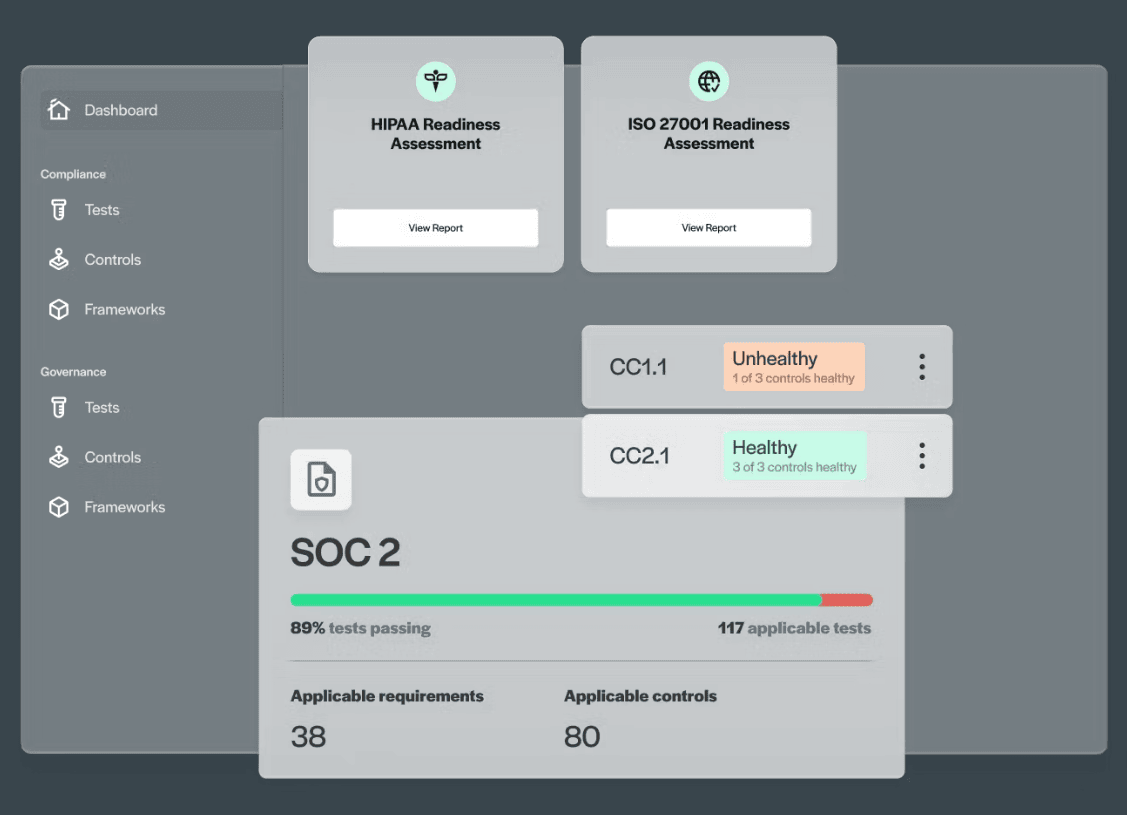
- A branded public portal where you can securely share compliance status, frameworks, and policies with customers.
- Helps shorten sales cycles by establishing trust upfront.
- Increasingly common among enterprise Secureframe customers who want transparency without manual NDAs.
Secureframe doesn't just store your compliance data; it works with it. It watches and alerts you when things go off track. This mix of automation and monitoring sets it apart from older GRC tools that still use checklists and spreadsheets.
It's not perfect. Some users want more flexible reports, and smaller teams may find the features overwhelming. Still, the range of functions is impressive. For most growing companies, it means knowing you're compliant instead of just hoping you are.
Secureframe's Compliance Automation
If regular automation tools are the engine, Secureframe's AI is the autopilot. It keeps you flying even when no one is at the controls.

Founders and security teams consistently highlight a key point in Secureframe reviews: it's not just another compliance dashboard. It's a system that learns. Instead of only flagging problems, it suggests solutions and, in some cases, fixes them automatically.
Here's how that intelligence plays out under the hood:
This blend of automation and intelligence is what gives Secureframe features their edge - not because it's flashy, but because it handles the mundane parts of compliance so your team doesn't have to.
Of course, not every user finds it perfect. Some Secureframe reviews mention the AI can over-flag issues early on or require fine-tuning as your setup matures. But when it's working right, it saves an enormous amount of manual effort - and maybe a few gray hairs before audit season.
P.S.- Want to find out how an AI-first compliance approach compares to its non-AI-first counterpart? Check out the OneLeet vs Delve blog for your next read.
Product Suite Breakdown
Once you get past the buzzwords, Secureframe's platform isn't just one big compliance dashboard - it's actually a suite of four core products, each tackling a different aspect of the trust problem. Together, they cover everything from day-to-day control tracking to enterprise-grade assurance.
Here's the quick tour:
Secureframe Comply - The Core Compliance Engine
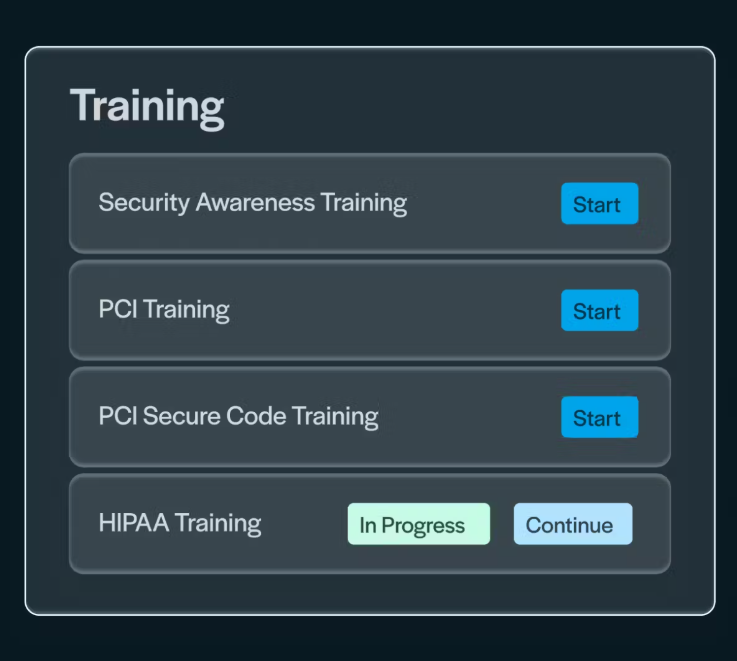
This is the backbone of the platform, where most teams begin.
- Automates end-to-end workflows: evidence collection, control mapping, testing, and reporting.
- Helps teams prep for audits (SOC 2, ISO 27001, HIPAA, etc.) without drowning in spreadsheets.
- Founders in Secureframe reviews often describe it as "the only way we stayed sane through audit season."
It's not glamorous work, but it's the reason many Secureframe customers stick around - it handles the boring parts of compliance consistently, so you don't have to.
Secureframe Trust - Bringing Sales and Security Together
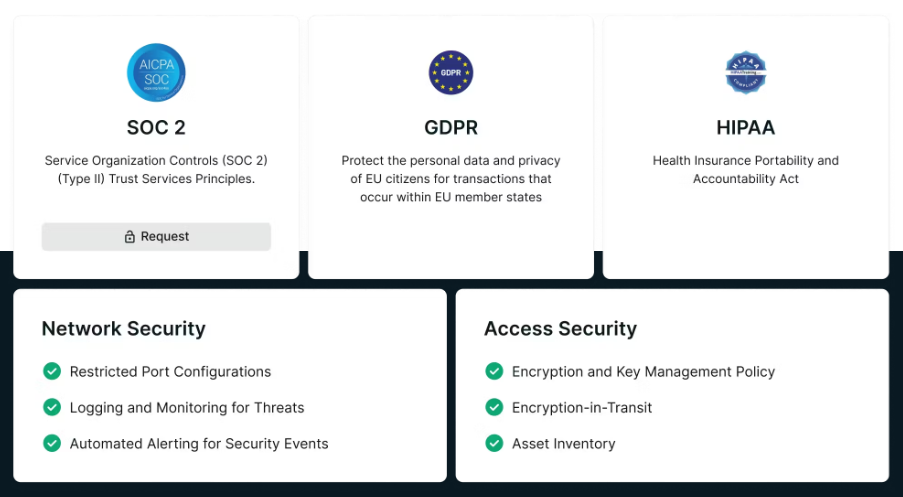
Think of this as your public proof of trust.
- Builds a branded Trust Center where you can share certifications, frameworks, and security posture.
- Integrates directly with your compliance data - so what customers see is always up to date.
- Helps shorten sales cycles by eliminating the "can you send your SOC 2?" back-and-forth.
This one's more outward-facing: it doesn't make you more compliant, but it makes your compliance visible.
Secureframe Federal - For the Heavily Regulated Crowd
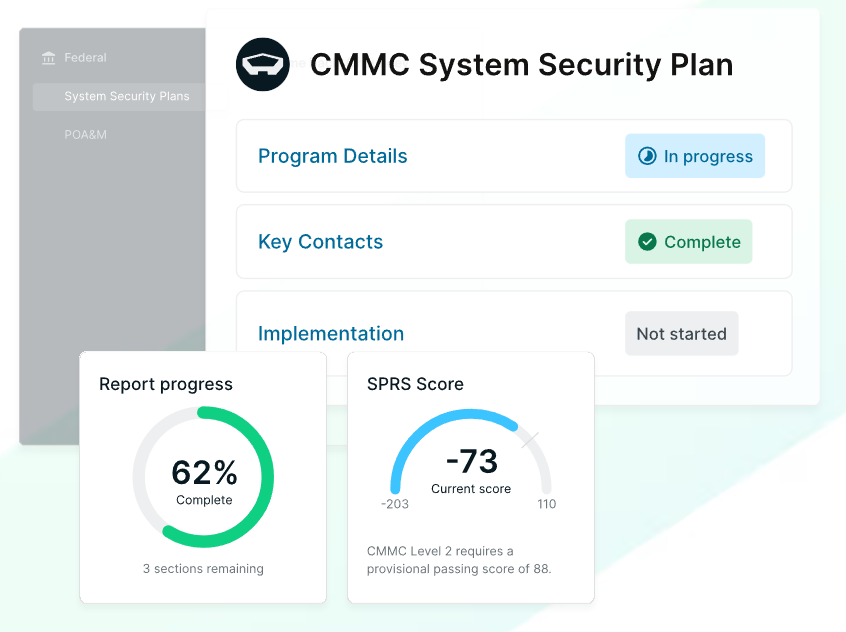
Built for companies chasing CMMC or FedRAMP certifications - i.e., anyone selling into the U.S. government or defense space.
- Includes documentation management for SSPs, POA&Ms, and scoring under the SPRS system.
- Handles frameworks that most automation platforms can't touch.
- It's a niche tool, but a serious differentiator - competitors like Vanta and Drata don't really go this deep.
If "public sector" is even remotely on your roadmap, this module alone puts Secureframe in a different league.
Secureframe Controls - The Unified View of Everything
Brings every framework, control, and test into a single customizable dashboard.
- Allows mapping shared controls across frameworks, reducing duplication.
- Perfect for fast-scaling companies juggling multiple certifications simultaneously.
- This is where Secureframe truly shines as a comprehensive security and compliance management platform, not just an automation tool.
These four products highlight what Secureframe offers: not just compliance, but operational trust.
While it's not perfect - some modules overlap, and smaller teams may not use the Federal side - the range is impressive. For companies expanding into enterprise territory, it's one of the few setups that grows with you.
That's why you often see Secureframe features in customer reviews. They're not just flashy; they truly deliver value.
Multiple Frameworks for Multiple Audits
Handling more than one compliance framework can be messy. If you've ever tried, you already know the struggle. Everything overlaps just enough to confuse but not enough to reuse your work. That's where Secureframe shines quietly.
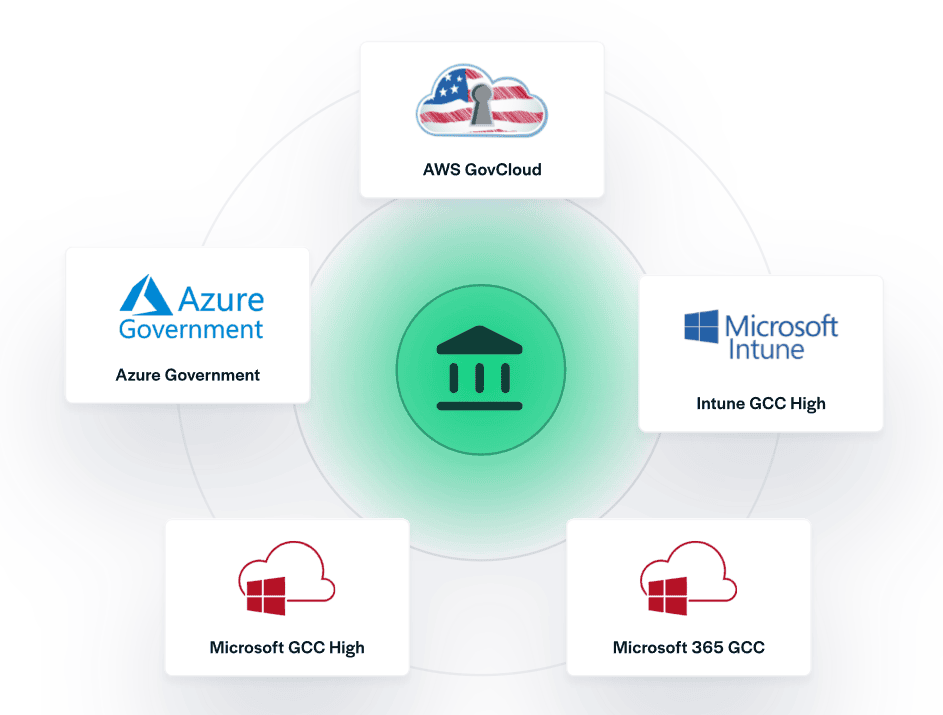
The platform supports 20+ compliance frameworks, including:
- SOC 2
- ISO 27001
- HIPAA
- GDPR and CCPA
- PCI DSS
- CMMC
- NIST 800-53
One of the most valuable Secureframe features is Common Controls. Instead of managing every framework separately, Secureframe connects overlapping requirements. This means you can reuse policies and evidence across frameworks.
For example, a single control for data encryption might count toward both SOC 2 and ISO 27001. That saves time, reduces errors, and makes audits far less stressful.
It's not fully automatic, though. Teams still need to review mappings and handle special cases. Frameworks like HIPAA and FedRAMP often have unique rules. Even so, Secureframe cuts manual effort by a wide margin.
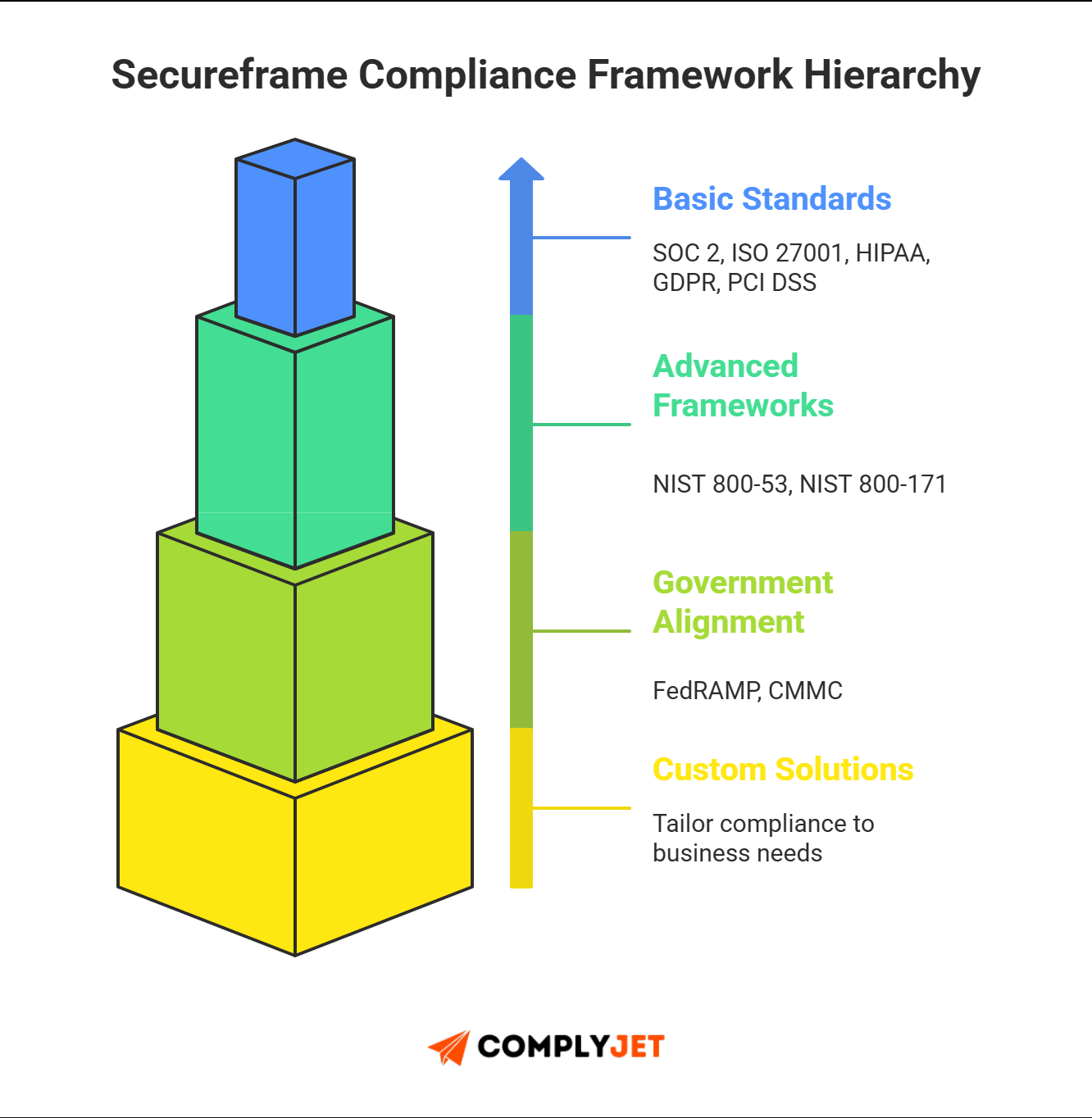
Secureframe reviews often emphasize this capability. It's not flashy, but it saves teams a lot of time. It makes multi-framework compliance easier, turning a logistical nightmare into a smooth, repeatable process.
That's the main idea: Secureframe doesn't reinvent frameworks; it just helps them work together better.
Picking Secureframe For Your Stage
Verified Secureframe reviews show that users have different reasons for choosing it. However, they all mention one key outcome: control. Whether you run a five-person SaaS company or a 5,000-person enterprise, Secureframe adapts to your compliance management needs.

Here's how it breaks down in practice:
For Small Businesses & Startups
- Designed for teams chasing their first compliance milestone - SOC 2, ISO 27001, or HIPAA.
- Built to achieve compliance with the frameworks you need to grow quickly.
- Includes access to Secureframe's in-house compliance experts who walk you through setup and audits.
- Turns your security posture into a sales advantage - proof of trust you can actually show to customers.
So, if you're selling to bigger clients and need compliance credibility fast, this is your on-ramp. It's structured, yet forgiving - a good fit for teams without a full-time security lead.
For Enterprises
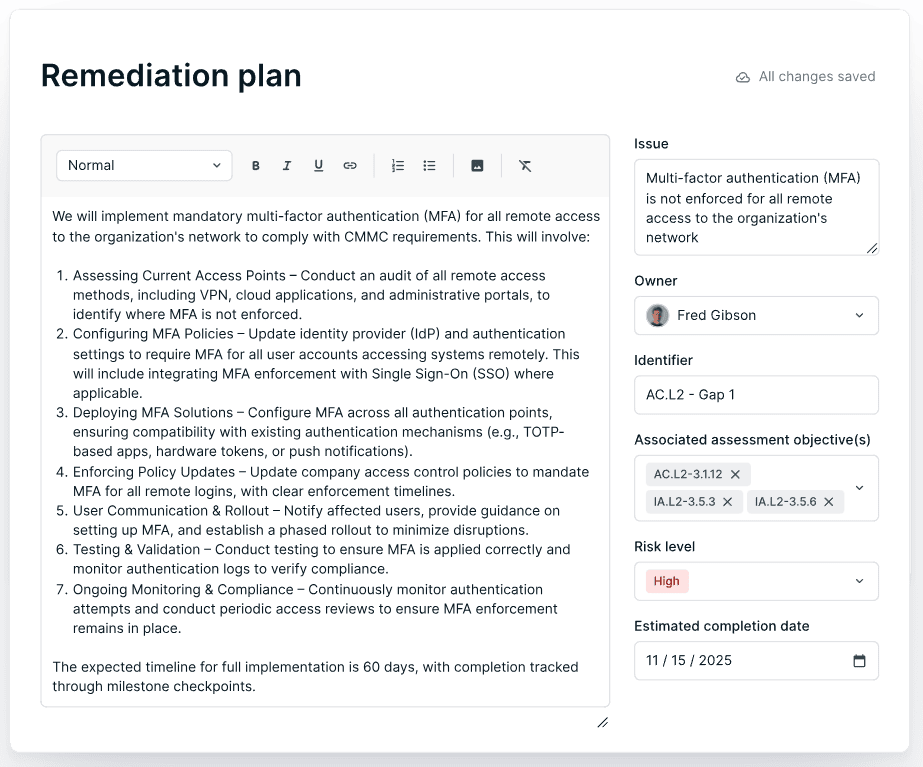
- Built to seamlessly integrate your existing technology stack - think AWS, Okta, Jira, ServiceNow, and beyond.
- Eliminates duplicative work that comes with maintaining multiple frameworks.
- Real-time dashboards keep leadership informed about security and compliance status at all times.
Enterprise users in Secureframe reviews often mention scalability. This means they can shift from one framework to five without starting over. It's not just about achieving compliance once; it's about maintaining it for the long term.
Is Secureframe Right For You?
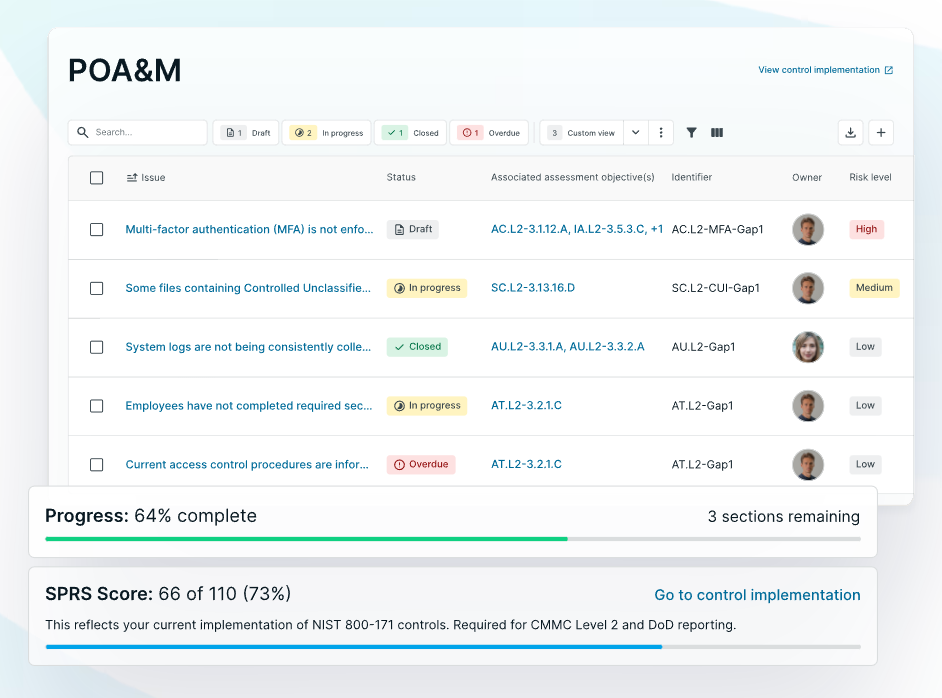
If your company deals with sensitive customer data, sells to regulated industries, or plans to grow, Secureframe is a solid choice.
It might seem too much for early teams still finding their way, but compliance can block sales. When that happens, Secureframe offers the structure you need.
For Secureframe customers juggling multiple frameworks or complex vendor systems, it makes a big difference. You can go from "we'll get compliant" to "we already are."
Want to explore Secureframe alternatives and see how they stack up? Check out our detailed Vanta vs. Drata review for a side-by-side comparison.
Secureframe Pricing Explained
Here's the thing about Secureframe pricing - it's not exactly front and center on the website. You won't find a neat little table telling you what you'll pay. Based on verified data and user-shared figures, we can break it down cleanly.
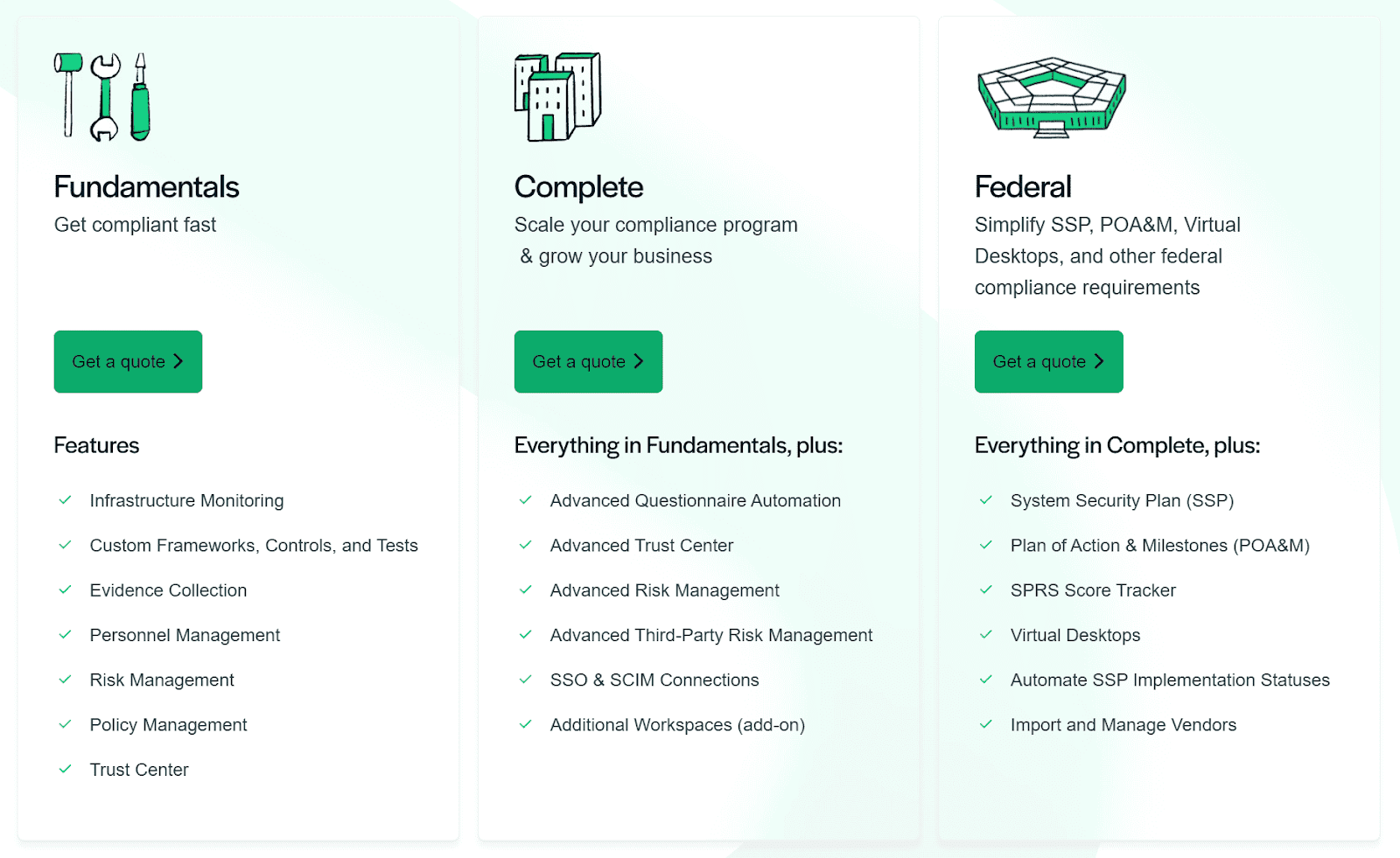
Secureframe runs on a 12-month base subscription model:
- Platform (up to 100 employees): $7,500/year
- First framework: $7,500/year
- Each additional framework: roughly another $7,500
That means most teams fall into these annual ranges:
- 1-20 employees: $7.5K-$15K
- 51-100: $20K-$26K
- 200+: up to $40K+
Large enterprise setups can reach $55K-$80 once you add frameworks and audit support.
There are also optional costs, like external audits ($8K-$50K), penetration tests ($5K-$20K), and renewals. Renewals often rise by 5-15% unless negotiated.
Secureframe reviews highlight two main points: the pricing is high, but it's worth it if you're replacing manual compliance work. However, smaller teams may find it hard to see ROI at first.
In summary, Secureframe pricing is on the higher side, but it offers peace of mind for teams wanting proper security and management.

For those comparing options, Complyjet has a different strategy. They offer transparent pricing on their website, so you won't face demos, NDAs, or hidden quotes before making a decision.
Turning Automation into ROI
The question most founders ask after hearing the price: Does it pay off? Based on real Secureframe reviews and case data, the answer is usually yes.
The company reports an ROI window of 3-6 months, primarily driven by automation and accelerated audits. As per their claims:
- Teams report saving up to $300,000 in annual labor costs, primarily from reduced manual evidence collection and consultant fees.
- Audit readiness improves by 60-80%, and the Trust Center shortens sales cycles by proving compliance faster.
Shared controls mean one policy can apply across multiple frameworks - another hidden time-saver.
Most Secureframe customers say ROI is more about time than cash. They gain hours to focus on building and selling, not preparing for compliance reviews.
For firms where compliance is a bottleneck, this is a huge operational boost. That's why even mid-sized teams often renew, despite the price.
Implementation and Timeline
Many tools promise "fast setup." Secureframe actually gets close - it depends on how complex your environment is.

Here's what most teams experience:
- SOC 2 Type I: Around 6-8 weeks for setup and readiness - focuses on assessing your controls at a single point in time.
- SOC 2 Type II: Typically 3-12 months, depending on your observation period - measures how well those controls perform over time, with 12 months recommended.
- ISO 27001: 8-16 weeks for complete alignment and certification prep.
- HIPAA: 6-12 weeks for compliance and policy validation.
The process rolls out in four simple phases:
- Setup (Weeks 1-2): Connect integrations, define assets.
- Controls (Weeks 3-4): Map, test, and attest.
- Automation (Weeks 5-12): Enable continuous tests and alerts.
- Audit (Months 4-6): Sample evidence and run final checks.
The heavy lifting usually falls between Engineering (integrations), Security (controls), and Sales (Trust Center setup).
Most users in Secureframe reviews say the initial setup feels like work - because it is - but once the Secureframe features are active, ongoing maintenance drops dramatically.

It's a sprint upfront for a marathon of saved hours later. However, if time is a factor - say a deal's on the line or an enterprise client is waiting for proof - Complyjet is a safe bet. You get full SOC 2 readiness in as little as 7 days, making it a solid option when speed and reliability both matter.
Secureframe's Security and Compliance Posture
Secureframe doesn't just automate compliance - it follows it. The company itself is certified for SOC 2 and ISO 27001, which sends a clear trust signal in a crowded market of automation tools.
- On the technical side, Secureframe uses:
- TLS 1.2 encryption for data in transit
- AES encryption for data at rest
- Role-based access controls (RBAC)
- Single sign-on (SSO) for identity management
It also runs ongoing security training, annual penetration tests, and continuous monitoring across all systems.
From a compliance standpoint, the platform is GDPR-compliant, supports data deletion upon request, and undergoes regular third-party audits to maintain transparent and trustworthy operations.

These aren't just checklist items. Real Secureframe customers count on built-in safeguards like encryption, RBAC, and monitoring. These protections hold up under audit pressure.
Many Secureframe reviews also praise the Secureframe Trust Center. It lets companies share verified audit data with clients and partners. This shows that their vendors are just as secure, which is vital for teams in regulated industries.
In short, Secureframe practices what it preaches. It stands out among competitors by following the same compliance standards it helps others achieve. Not every platform can claim this credibility.
Secureframe Reviews by Real Users
Across platforms like G2, Capterra, and AWS Marketplace, Secureframe consistently scores high - averaging 4.6-4.7 out of 5. But the feedback isn't just about the rating; it's about what founders, security leads, and compliance managers actually say after using it.
When you read through multiple Secureframe G2 reviews and verified insights on adjacent review platforms, a few patterns start to stand out: users love the automation and support, but they also have strong opinions on cost and complexity.
Here's a summary of what real Secureframe customers are saying:
Positive Reviews
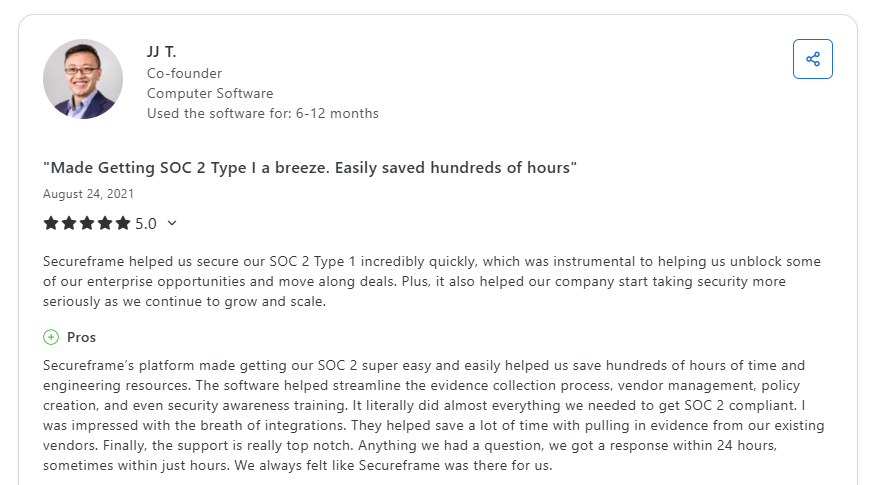
✔ Time-saving automation: Many users on G2 mention how Secureframe "cut audit prep time by weeks" and "made evidence collection nearly automatic."
✔ Ease of use: Capterra reviewers often describe the platform as "intuitive and well-structured," even for teams new to compliance.
✔ Excellent onboarding: Several Secureframe G2 reviews credit Secureframe's support and onboarding specialists for guiding them through complex frameworks, such as SOC 2 and ISO.

✔ Integration depth: Users frequently call out seamless connections with AWS, Google Workspace, and Okta - "a lifesaver for small security teams."
✔ Strong documentation & templates: Policy templates are praised for being "accurate, flexible, and easy to customize."
✔ Real-time visibility: Customers value how dashboards simplify control tracking and compliance management, letting teams monitor audit progress live.
✔ Responsive customer support: Many reviewers specifically highlight fast, knowledgeable responses from Secureframe's support team - especially through Slack, where questions are often resolved within minutes.
Negative Reviews

❌ Pricing pain points: Smaller startups often mention that Secureframe's cost structure feels steep for early-stage companies.
❌ Limited reporting flexibility: Some users wish for "more customizable exports" and advanced analytics.
❌ Overwhelming features: A few teams say the platform "does a lot - maybe too much" for companies just starting their compliance journey.

❌ UI permissions: Certain reviews note role management can feel restrictive for teams that want more granular access control.
❌ Sync delays: Occasionally, users report minor delays in integration syncs or control.
Overall, Secureframe reviews show a clear sentiment: it has become a leader in security and compliance automation. Users praise its reliability and extensive features. However, cost and scope can be issues for smaller teams.
For larger customers, the value is evident. Secureframe scales well with compliance needs and handles audits effectively.
FAQs: Founders' Most Asked Questions
People often have the same core questions when they start researching Secureframe, such as how it compares, what it costs, and whether it's the right fit for their stage.

Here are the top 5 questions founders usually ask:
Why choose Secureframe over Drata or Vanta?
Dive into the world of verified Secureframe reviews, and one fact shines bright: Secureframe is all about expert support and tailored solutions. In contrast, Drata and Vanta lean into the realm of self-service automation.
If your team craves hands-on guidance from compliance wizards, Secureframe often takes the crown.
Yet, if speed or simplicity is your mantra, users sometimes scout for alternatives like Vanta, Drata, or Complyjet. These options promise quicker onboarding and pricing that's crystal clear.
How much does Secureframe cost in 2025?
Secureframe pricing usually starts at about $7,500 per year for the basic platform and framework. Costs rise with team size and any added frameworks.
While it is pricier than some competitors, many users on G2 find it worthwhile. They appreciate the extensive automation and thorough security compliance it offers.
Final pricing often requires a sales call, so budget a little flexibly.
What are the best Secureframe features for startups?
Founders highlight three major Secureframe features in most Secureframe reviews:
- Continuous monitoring to catch compliance gaps before audits.
- Automated evidence collection that saves hours every week.
- Policy templates that make setting up a framework for the first time painless.
In short, it removes 80% of the grunt work, allowing smaller teams to focus on building, not documenting.
Who uses Secureframe most - startups or enterprises?
Both, but for different reasons.
- Startups use it to get their first SOC 2 or ISO certification quickly.
- Enterprises use it to manage multiple frameworks and maintain year-round readiness.
Secureframe reviews often mention scalability - you can start small and keep expanding as compliance complexity grows.
What's the best alternative if time is critical?
If timelines are tight - say you're losing deals because a client needs audit proof now - Secureframe might feel too heavy to start.
That's where Complyjet often emerges as the practical choice: fast implementation, transparent pricing, and full SOC 2 readiness in just 7 days.
The Final Takeaway
After reading through hundreds of Secureframe reviews, one thing is clear. This platform carries real weight. The range of Secureframe features and the number of frameworks it supports make it a strong choice for teams that take security and compliance seriously. It's more than a checklist app - it's built as infrastructure for scaling trust.
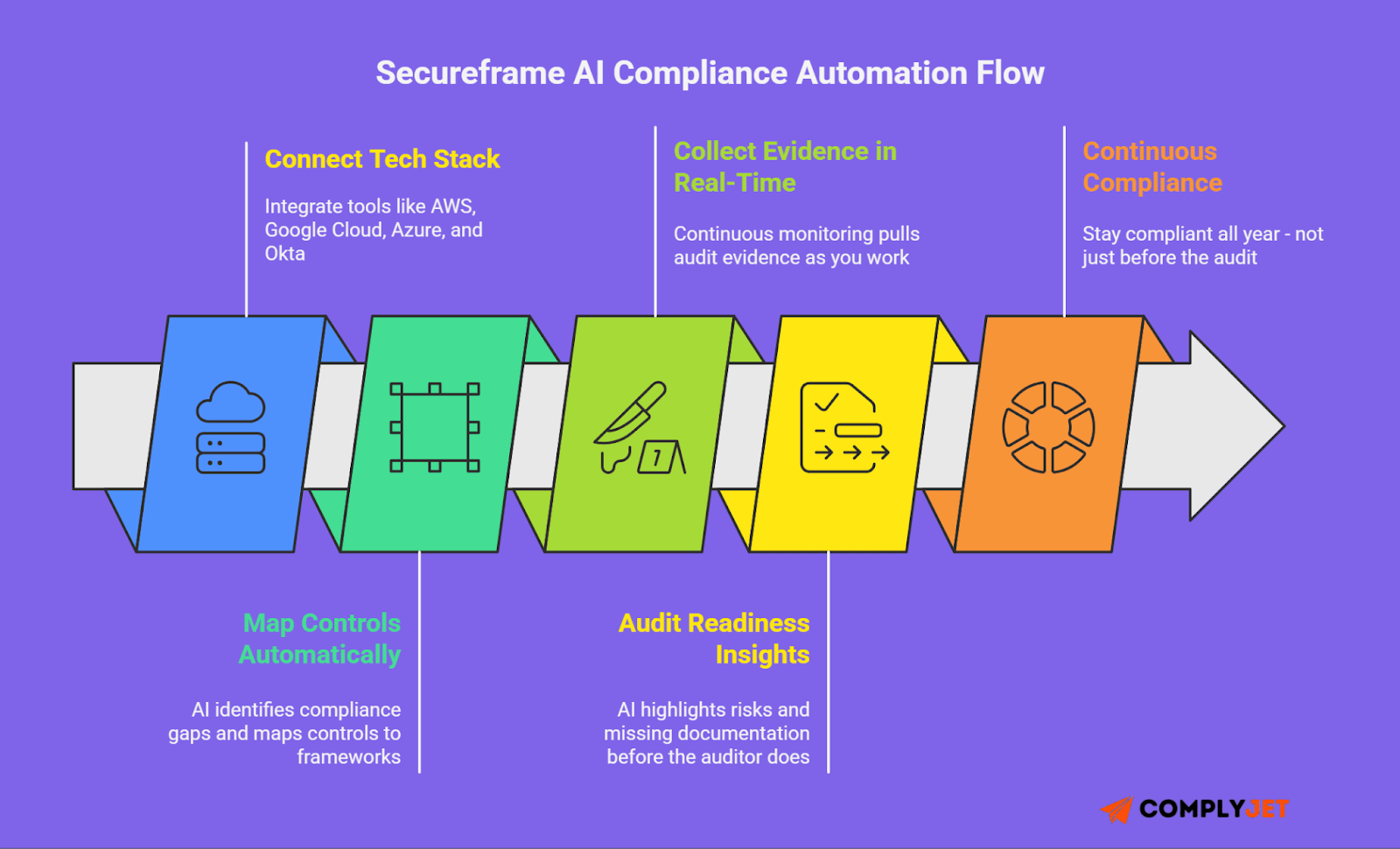
But that power comes at a price. Secureframe pricing sits in the enterprise tier. It's a great fit for larger organizations with compliance teams, but it can feel cumbersome for startups that need to get audit-ready quickly.
That's where Complyjet comes in. It's built for founders and fast-moving teams who want the same level of trust and rigor as enterprise tools - without the long setup or hidden costs. Transparent pricing and quick implementation make it a practical Secureframe alternative.
If Secureframe is the heavyweight option for complex compliance, Complyjet is the modern Secureframe competitor - lighter, faster, and built for growth.
Start your free trial today and see how simple audit readiness can be.
Or, talk directly to our founders - people who've lived through the startup chaos and built a tool to end it.
Ultimately, trust is what both platforms sell. The difference is in how fast you get there - and that's where Complyjet delivers.



